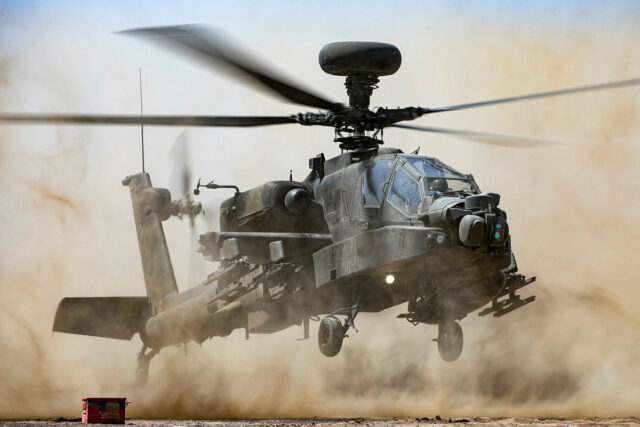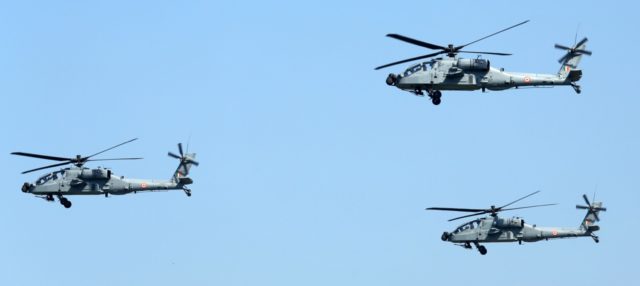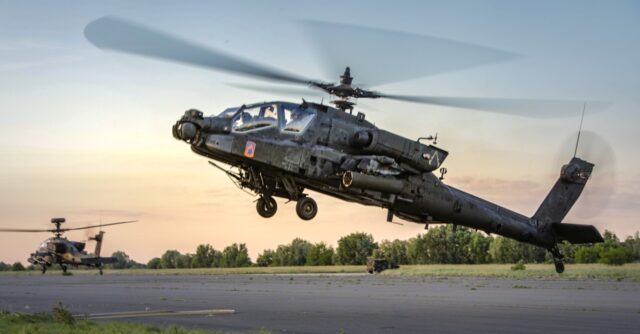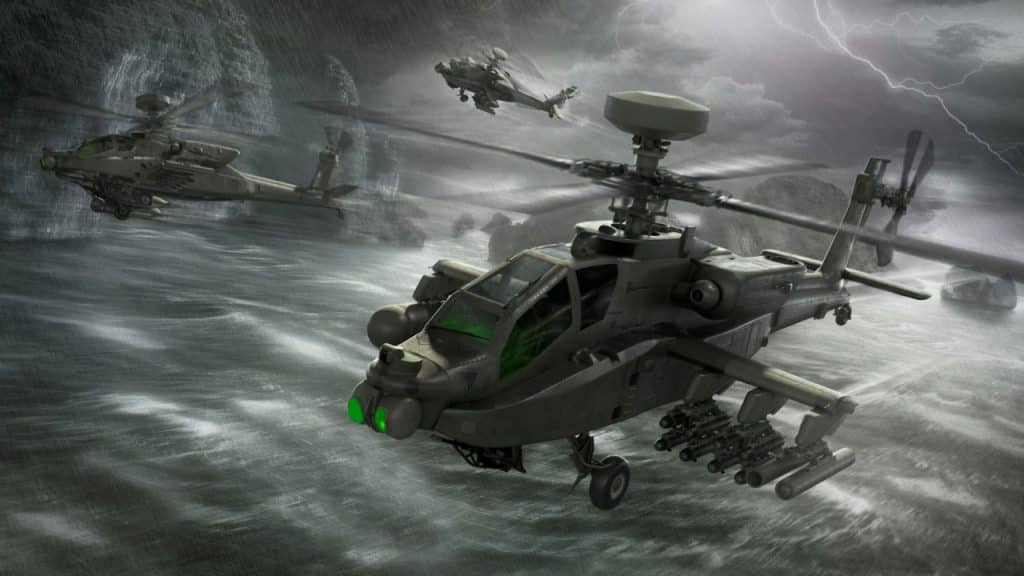The AH-64 Apache attack helicopter is one of the most successful designs in the global history of combat rotorcraft. Although it was flown in 1975 – which makes the Apache almost the same as the F-16 – it can be assumed that, like the Fighting Falcon, it has roughly as many years of service ahead of it as it has behind it. And just like Fighting Falcon, the AH-64 is still under development. The Boeing concern has just presented a vision of the next version of Apache, which includes some interesting modifications.
The artistic vision presented during the annual Washington convention of AUSA attracts attention mainly with the larger wings with three weapon suspension points instead of the previous two. The helicopter will be able to carry the entire range of weapons to date, but the Boeing announcement highlights two new categories: energy (i.e. laser) weapons and Air Launched Effects. The latter concept covers miniature unmanned aerial vehicles that will perform reconnaissance, surveillance, intelligence and electronic warfare tasks, and will act as circulating ammunition.
Of course, the changes do not end with increasing the amount of weapons. The GE T901 engine (selected in the ITEP program – Improved Turbine Engine Program) is to appear in the new Apache, working without any invention as Modernized Apache. Together with the modifications to the propulsion system, it is to provide the helicopter with higher top speed and range, as well as lower fuel consumption. There is also a different outlet for exhaust gases, which is likely to reduce the infrared signature of the helicopter.
The changes will also include electronics: the helicopter is to be more network-centric and provide the crew with better situational awareness with a lower workload and cognitive load thanks to the so-called sensor fusion (known for example from the F-35). The US Army will most likely want to apply the results of work on the optional manned UH-60 here. The autonomous flight control system with elements of artificial intelligence can support the pilot in critical phases of the combat task, when it is necessary to watch out for obstacles on the ground, threats from the enemy, target selection and his shock at the same time.

British Apache AH Mk.1.
(SAC Charlotte Hopkins RAF / UK MOD © Crown copyright 2021)
However, nothing has been disclosed about self-defense systems. It is known that the US Army wants to integrate the already owned AH-64s with the DIRCM (Directional Infrared Counter Measures) system, which is designed to blind and confuse infrared guided missiles. So it can be assumed that DIRCM will also appear on new Apaches.
Defense against infrared guided weapons is becoming an increasingly pressing problem for both helicopters and airplanes. This was clearly recalled by the war in Ukraine, where new videos are regularly made showing the knocking down of Russian helicopters with infrared guided missiles from portable launchers. The biggest problem is that such missiles aim passively at the heat signature, so neither the airmen nor the aircraft’s avionics may be aware of the threat until it is too late. Therefore, it is necessary to limit the heat emission so as to make it difficult for the Seeker to capture the target.
This morning in the Kyiv region UA Armed Forces destroyed Russian attack helicopter Mi-24 with MANPADS.
Near Chernihiv UA forces shot down a Su-34 fighter-bomber. One of the pilots is captured, says he didn’t know that he was flying to bomb a peaceful city. Shameless liars. pic.twitter.com/xy0EtGope9
– Maria Avdeeva (@maria_avdv) March 5, 2022
Returning to the Apache, let’s take another note of what Boeing calls Advanced Maintenance. The new Apache, compared to the previous versions, is to be simpler and cheaper in the current use, while offering greater possibilities. In addition, Boeing promises a low conversion cost, referred to as remanufacture, i.e. modification of an already existing airframe deep enough to be considered as re-production. The AH-64D is now being converted to Guardian by the same principle.
Joseph Trevithick points out that the two-pipe launcher under the left wing of the helicopter in the artistic vision are most likely Common Launch Tubes. These are universal launchers that can be integrated with almost any type of aircraft, on which there is an adequate amount of space and reserve capacity. They can be used to launch, among others, GBU-69 Small Glide Munition gliding bombs, AGM-176 Griffin and GBU-44 / E Viper-E guided missiles or small unmanned reconnaissance aircraft. In turn, the container under the right wing can be a laser.

The Indian AH-64E formation.
(Ministry of Defense, Government of India)
What we see above the rotor is also interesting. The radar fairing differs from that used on the current AH-64s. This may mean that Boeing plans to replace the AN / APG-78 Longbow with a new device, but it may simply be a new fairing concealing old guts. A new radar with greater capabilities would, however, harmonize with the integration of new weapons with a greater range.
Finally, it was announced that the new Apache will be designed according to the philosophy of modular construction. This is to facilitate the further integration of new solutions (both hardware and software) developed in the course of the helicopter’s service.
The new generation of Apache will be based on a variant labeled Version 6, which was revealed four years ago. One gets the impression that the V6 was developed as a kind of pavement for a more comprehensive modernization. Also there, systems increasing situational awareness or enabling cooperation with UAVs were introduced to the avionics package. The entire US Army AH-64 fleet is to be brought to V6 standard in 2026.

AH-64D during exercises in Hungary.
(Sgt. Preston Malizia)
It should be emphasized, however, that the Modernized Apache is a relatively conservative vision compared to what was presented four years ago. At that time, Apache was also announced with six wing hangpoints, but that was perhaps the least interesting element of the vision.
As we wrote then, the machine called AH-64E Block 2 Compound was to be equipped with a articulated main rotor, an additional five-bladed push propeller, wings with nearly twice the span and a profile providing greater lift, and a redesigned vertical stabilizer, mounted – for a change – from the bottom tail beam. In this case, the drive was to be provided by the engine selected in the ITEP program. In addition, the helicopter was to receive a retractable main landing gear and the gun was placed under an aerodynamic fairing.
Sadly, this Modernized Apache concept does not feature the pusher-propeller configuration of earlier announcements (which also has the larger wing), but maybe that will come with a later AH-64F or even G… pic.twitter.com/lbly7JZsJ3
– Gareth Jennings (@ GarethJennings3) October 10, 2022
The project has reached a relatively advanced stage of development. The 1: 3 scale model was tested in the manufacturer’s wind tunnel in Philadelphia. There were also rumors of building a full-size mock-up. It was assumed that the hybrid Apache will be half the speed of the original (maximum speed of 400 km / h), it will have half the range, one quarter less fuel consumption and twice the life cycle of the structure than the Guardian. All for just 20% more than the regular AH-64E. Ultimately, however, the program (unfortunately?) Died a natural death.
It is expected that the AH-64s will be in service with the US military until around 2050. In other countries, especially those for which Apache is a relatively new purchase (such as India or potentially Poland), the helicopter may be withdrawn from service ten or twenty years later. Much will depend on whether Apache continues to undergo successful upgrades. And the manufacturer, as you can see, predicts that it will be.
See also: Sentenced in the USS Bonhomme Richard arson trial
Boeing

